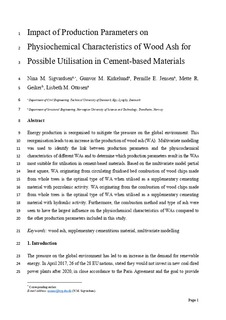| dc.contributor.author | Sigvardsen, Nina Marie | |
| dc.contributor.author | Kirkelund, Gunvor M. | |
| dc.contributor.author | Jensen, Pernille E. | |
| dc.contributor.author | Geiker, Mette Rica | |
| dc.contributor.author | Ottosen, Lisbeth M. | |
| dc.date.accessioned | 2019-08-16T11:04:13Z | |
| dc.date.available | 2019-08-16T11:04:13Z | |
| dc.date.created | 2019-03-15T21:24:06Z | |
| dc.date.issued | 2019 | |
| dc.identifier.citation | Resources, Conservation and Recycling. 2019, 145 230-240. | nb_NO |
| dc.identifier.issn | 0921-3449 | |
| dc.identifier.uri | http://hdl.handle.net/11250/2608740 | |
| dc.description.abstract | Energy production is reorganised to mitigate the pressure on the global environment. This reorganisation leads to an increase in the production of wood ash (WA). Multivariate modelling was used to identify the link between production parameters and the physiochemicalcharacteristics of different WAs and to determine which production parameters result in the WAs most suitable for utilisation in cement-based materials. Based on the multivariate model partial least square, WA originating from circulating fluidised bed combustion of wood chips made from whole trees is the optimal type of WA when utilised as a supplementary cementing material with pozzolanic activity. WA originating from the combustion of wood chips made from whole trees is the optimal type of WA when utilised as a supplementary cementing material with hydraulic activity. Furthermore, the combustion method and type of ash were seen to have the largest influence on the physiochemical characteristics of WAs compared to the other production parameters included in this study. | nb_NO |
| dc.language.iso | eng | nb_NO |
| dc.publisher | Elsevier | nb_NO |
| dc.rights | Attribution-NonCommercial-NoDerivatives 4.0 Internasjonal | * |
| dc.rights.uri | http://creativecommons.org/licenses/by-nc-nd/4.0/deed.no | * |
| dc.title | Impact of production parameters on physiochemical characteristics of wood ash for possible utilisation in cement-based materials | nb_NO |
| dc.type | Journal article | nb_NO |
| dc.type | Peer reviewed | nb_NO |
| dc.description.version | acceptedVersion | nb_NO |
| dc.source.pagenumber | 230-240 | nb_NO |
| dc.source.volume | 145 | nb_NO |
| dc.source.journal | Resources, Conservation and Recycling | nb_NO |
| dc.identifier.doi | 10.1016/j.resconrec.2019.02.034 | |
| dc.identifier.cristin | 1685269 | |
| dc.description.localcode | © 2019. This is the authors’ accepted and refereed manuscript to the article. Locked until 6.3.2021 due to copyright restrictions. This manuscript version is made available under the CC-BY-NC-ND 4.0 license http://creativecommons.org/licenses/by-nc-nd/4.0/ | nb_NO |
| cristin.unitcode | 194,64,45,0 | |
| cristin.unitname | Institutt for konstruksjonsteknikk | |
| cristin.ispublished | true | |
| cristin.fulltext | preprint | |
| cristin.qualitycode | 1 | |

